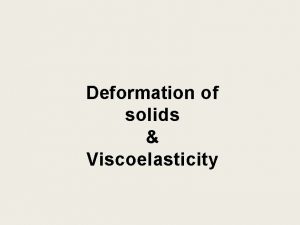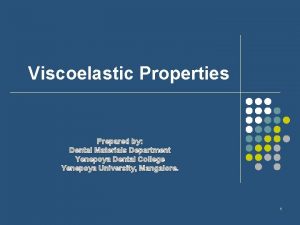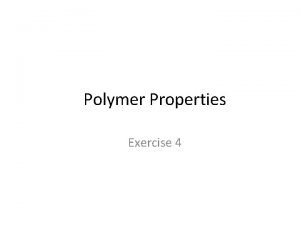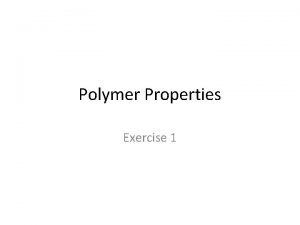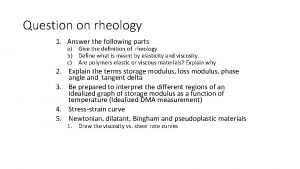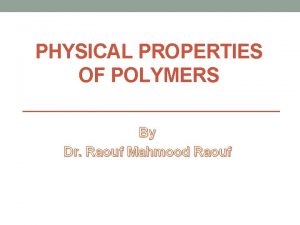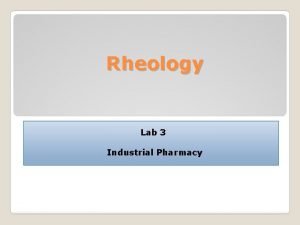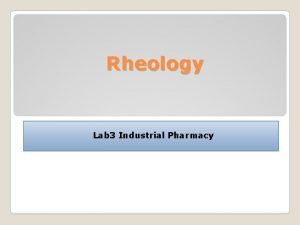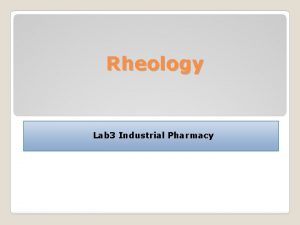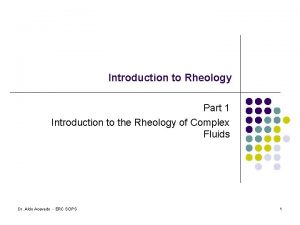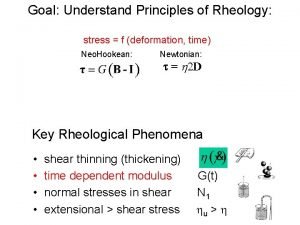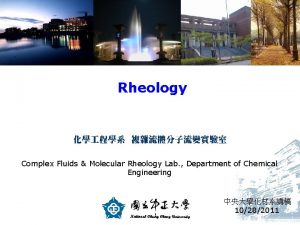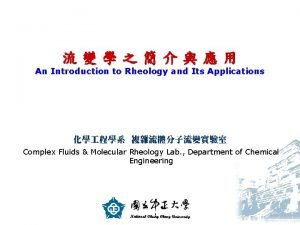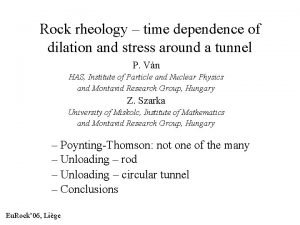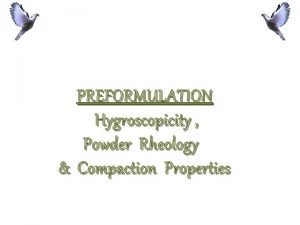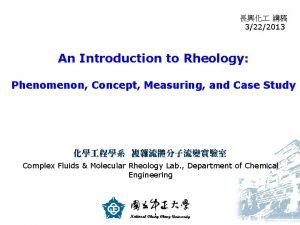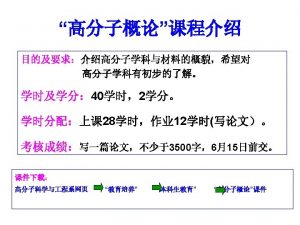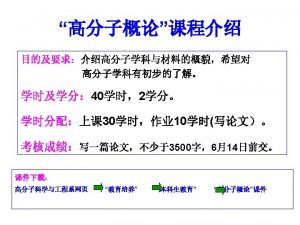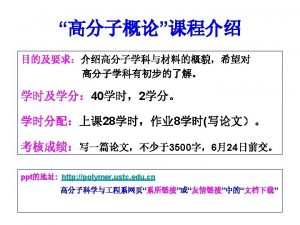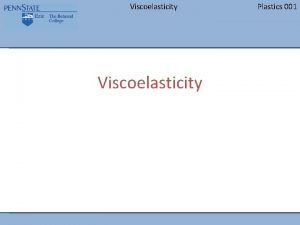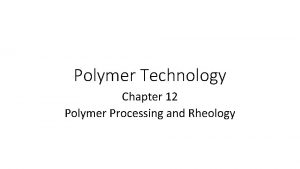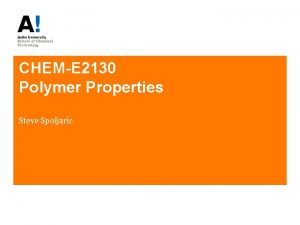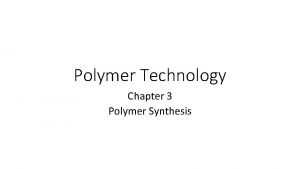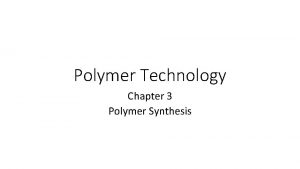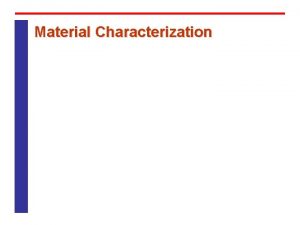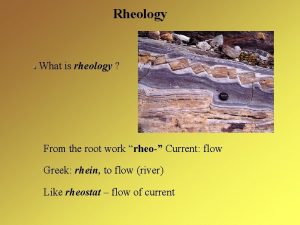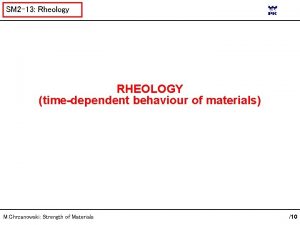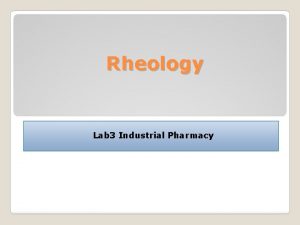Polymer Properties Exercise 4 Viscoelasticity and rheology Effect


















- Slides: 18

Polymer Properties Exercise 4

Viscoelasticity and rheology Effect of molecular weight on viscosity Effect of temperature on viscosity • Above the critical molecular weight the zero viscosity of polymer can be calculated using equation: • For amorphous polymers above the glass transition, WLF equation can be applied: • Below the critical molecular weight the constant is 1. 0, above the critical molecular weight = 3. 4. • Zero viscosity is determined by rheology measurement: dynamic viscosity at zero frequency. Reference temperature Ts C 1 = 8. 86 and C 2 = 101. 6 Reference temperature Ts = Tg C 1 = 17. 44 and C 2 = 51. 6

1. Viscosity • Viscosity of an amorphous PVC was measured to be 3. 9 105 Pa s at temperature 122 o. C. For processing, the viscosity should be below 2 104 Pa s, but at least 5000 Pa s. • At what temperature should the processing be done?

1) • Amorphous PVC follows WLF equation in the temperature range T = Ts 50 °C. • Solve for the temperature at which the viscosity is at most 2 104 Pa s :

1) • When the lowest acceptable viscosity is 5000 Pa s, the temperature is: • Processing should be done within the temperature range 139 - 149 o. C.

2. Viscosity and Mw Zero viscosity of a linear polyethylene was determined to be 676000 Pa s at 190°C. For polyethylene the constants for comparison of Mw and zero viscosity are k = 3. 4 10 -15 Pas and = 3. 5. The temperature dependence of the viscosity of PE in melt can be estimated with Arrhenius-type equation. a) What is the molecular weight Mw of PE? b) How much should the temperature be altered in order to reduce the viscosity by half?

2 a) • The weight average molecular weight for the polymer can be calculated from equation:

2 b) • Temperature dependence for the viscosity by Arrhenius: • When viscosity is reduced by half by altering temperature:

2 b) • Activation energy for HDPE is 27 k. J/mol, the temperature can be solved: =1/0. 001946 T 2=513. 8 K = 241°C • The temperature should be increased by 51 °C in order to reduce the viscosity by half.

3. Stress-strain (Creep) • Tensile stress • Strain shear stress • Shear rate • Viscosity • Creep compliance

3. Creep • Polypropylene PP rod attached to the ceiling (length 200 mm, width 25. 0 mm, thickness 3. 0 mm) is loaded with 30 kg´s. How much will the polymer creep in two minutes when the creep compliance J(t) follows the equation (t is time in minutes)? J(t) = 1. 5 - exp(-t/6 min) GPa-1

3) • Stress imposed on the cross section of the polymer rod is: • Creep at the moment t is obtained from the Strain: • Where

3) • Creep at two minutes: • PP rod has strained during the two minutes time:

4. Viscosity and chain length • When the polymer chain are long enough to form stable entanglements, longer than the critical chain length Zw > Zc, w, the polymer viscosity and chain length Zw can be connected by: where K is a constant

4) • The usual processing temperature of polystyrene cups is 160 o. C and the melt viscosity is then 1. 5 102 Pa s, provided that the mainchain length of PS is Zw = 800. The quality of the polymer however varies and one day the Zw = 950. Processing is tuned for a particular viscosity range. • How should the processing temperature be altered so that the melt viscosity would still be 1. 5 102 Pa s? Glass transition temperature of PS is 100 o. C.

4) • Viscosity is increased when the molecular weight increases. By increasing the temperature the viscosity can be kept lower. • Solving the constant K first: • Viscosity of the novel polymer grade at 160 o. C:

4) • The viscosity of this polymer at the glass transition temperature can be obtained using WLF equation: • The new processing temperature T 2 can be solved from WLF equation:

4) The processing temperature should be about 4 o. C higher so that the viscosity would remain the same.
 Example of viscoelastic material
Example of viscoelastic material Viscoelasticity in dentistry
Viscoelasticity in dentistry Polymer exercise
Polymer exercise Polymer exercise
Polymer exercise Rheology exam questions
Rheology exam questions Polymers physical properties
Polymers physical properties Powder rheology lab
Powder rheology lab Rheology in pharmacy
Rheology in pharmacy Rheology in pharmacy
Rheology in pharmacy Introduction to rheology
Introduction to rheology Rheology
Rheology Dilatant rheology
Dilatant rheology Blood rheology definition
Blood rheology definition Rheology lab
Rheology lab An introduction to rheology
An introduction to rheology Aerc rheology
Aerc rheology Rock rheology
Rock rheology Flow properties in preformulation
Flow properties in preformulation An introduction to rheology
An introduction to rheology
